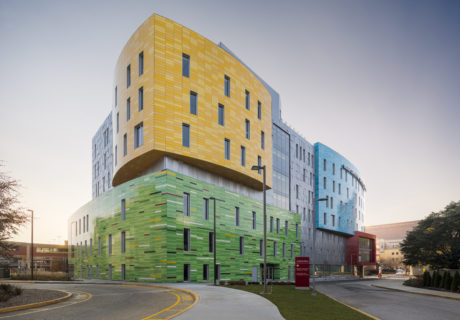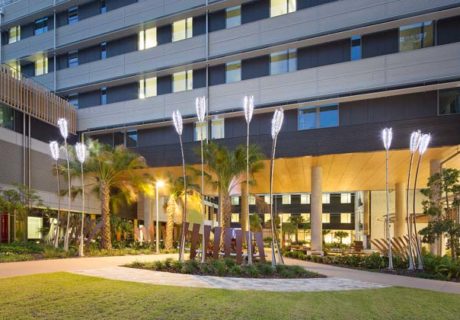Alder Hey’s Park Place
In 2010, Alder Hey Children’s Hospital in Liverpool, England, was feeling some growing pains. Over the years, several additions had been made to the 100-year-old campus’s two- and three-story buildings, creating inefficient and labyrinth-like circulation routes. This development was largely fueled by an evolution in demand for specialty services in the pediatric market, with Alder Hey seeing the most activity in the areas of cardiac and neuroscience care.
“Alder Hey grows roughly 5 percent a year and has for the last 10 years,” says David Powell, development director at Alder Hey Children’s NHS Foundation Trust. “As you grow, you start randomly bolting things on and [the hospital] starts to lose its coherence.”
Recognizing the need for a new facility built to modern-day standards, Alder Hey turned its sights to its next door neighbor—the 22-acre Springfield Park—with the idea to build a hospital adjacent to the park and then demolish its existing facility and replace it with more green space. “It gave us the opportunity to design the park into the building,” Powell says.
After earning neighborhood support, the hospital conducted a land swap with the city of Liverpool and then began defining the design goals for its new home. Alder Hey sought input from families, staff, and patients, who were asked to draw an image of what they’d like to see in a new hospital. “Ninety percent of the images were about the outside,” Powell says. “What that said to us was they wanted something to connect them to those things.”
But Alder Hey didn’t just want a building in the park, Powell says: “That would have been a missed opportunity.” Instead, the provider wanted something “grand” that would “set a new mark” for the organization. London-based BDP entered the subsequent design competition and won the project.
Benedict Zucchi, a director at the firm and the lead architect on the project, says he was skeptical at first upon hearing Alder Hey’s goals. “I thought that they were sort of clichés and that it was just another way of saying they wanted a building of quality,” Zucchi says.
But when BDP presented a series of design proposals, Alder Hey chose the most radical of them all, called “Hill in the Park,” which included a building profile with exposed surfaces to mimic the characteristic red sandstone of Liverpool and patient wards projecting out like ripples of landscape. “That’s when we realized that there was real ambition on their part to do something innovative,” Zucchi says.
Building a park into a hospital
Turning that ambition into reality was a lengthy process involving the nearly two-year design competition phase followed by 20 months of design development. Construction started in 2013, and the 645,834-square-foot hospital opened in October 2015. The functional program called for 270 beds, a large critical care area, 16 operating theaters, and outpatient services. BDP added another goal to the project list: to provide every room with a view of the park.
The first step was to orient the building from north to south on the new 12-acre site to maximize daylight and park views from all of the rooms. Then, instead of a traditional stacked hospital, BDP proposed a trio of green-roofed buildings, or “fingers,” that are joined at a main concourse, which allows the buildings, courtyards, and park to interweave “like hands embracing,” Zucchi says.
The lower floors of the three buildings house clinical services and departments, including the operating theaters, imaging, and an emergency department, while an interstitial level for offices and building services is located on one of the middle floors of each of the buildings. The top two floors with the best views are reserved for the patient wards. The approach resulted in a site that’s half the size of the former hospital and with nearly 90 percent of the patient rooms and 70 percent of the inhabited rooms getting a view to the park, Zucchi says. The other patients room face south toward the main road and entrance plaza.
The natural slope of the park site and the undulating shape of the three buildings provide a memorable design but also one that was flexible enough to adapt to changes that occurred over the course of the project. For example, after the initial design phase, Zucchi says it was clear that the surgery department needed to be bigger, so the footprint of the lower floors in that building was widened.
“It didn’t really matter if it was wider or longer because we could just play with the shape within the overall profile of the hill,” Zucchi says. “There was no perfect form we were trying to stay true to.”
In another mid-project alteration, Alder Hey asked to move more patient beds in the critical care unit to the outside wall of the middle building to increase access to daylight. The change was achieved by reconfiguring the rectilinear layout with clusters of eight beds and a central staff area that would bow out from the building in a series of scalloped shapes.
“We could leave the upper floors the way they were and just accept that we gained a kind of roof garden above those areas and go with the flow of it,” he says.
Playful features
The clinical buildings connect to a bright and airy five-story concourse that runs north to south on campus and serves as the main spine. Visitors enter from either the main entrance at the south end or a new 1,200-space garage on the east side. The atrium houses the main reception area, a café/restaurant, outpatient arrival and reception, meeting and conference rooms, retail, and a performance space. The two public elevators sit between the clinical buildings.
“What helps you navigate is that whichever level you’re on, you always have either the concourse or the park as a reference point,” Zucchi says.
Timber arches made of composite wood reach out over the curved metal-decking ceiling. A large, wooden mobile by artist Lucy Casson adorned with animal characters hangs above, while at the northern end of the atrium a conical-shaped enclosure, called the Treehouse, is clad in Western red cedar and houses a multi-faith chapel on one level and a teen lounge on the top.
A soft color scheme comes into play in the clinical areas, where varying shades of a single color are used on each floor to demark staff and patient areas, such as hues of yellow in the critical care unit. In the bed wards, Powell says that Alder Hey wanted its new facility to reflect the industry standard for private patient rooms while recognizing that some pediatric patients may do better in shared rooms—so the hospital houses two groupings of four-bed bays along with 24 private rooms with en suite bathrooms.
“There’s no absolute science to dictate the way to do it,” Powell says. “It’s more a judgement that it’s the right thing to do.”
Zucchi says each multi-bed bay measures close to 700 square feet, which didn’t quite fit within the standardized floorplate depth, so the bays were designed to stick out from the profile of the building and are clad in anodized aluminum panels to give them a shiny, jewel-like appearance. “It helps animate the façade and alludes to the child-friendly nature of the building,” he says. “You get a bit of playfulness in all of the elevations.”
Tech the halls
No hospital these days is complete without a host of technology features, and Alder Hey is no different. When the project started in 2010, Powell says the operator wanted to lay the foundati
on for a “living hospital” that would be able to respond to inhabitants and their needs as the necessary technological advancements become available.
The proper infrastructure was put in place during construction, and the hospital is now working on rolling out several tech-savvy features, such as automated greeting systems that will respond when someone enters the hospital. In the clinical areas, the operating theaters include video equipment and streaming capacity to connect with providers and specialists in other locations.
For patients, the hospital is in the pilot stages of a project that will allow children to design their own characters before they’re admitted and then have these “friends” appear on the TVs in patient rooms and on the walls in treatment spaces. Powell says the personalized feature will be activated by the children logging into an account they create and will also support communication with family at home or elsewhere in the hospital.
“It’s trying to make it more comfortable and fun for the patients,” he says.
Getting noticed
While improving the patient experience, Alder Hey also set out to make upgrades that reflected the latest in healthcare delivery, including the separation of public, clinical, and facilities management flows. To achieve this, all the goods coming in and waste going out are handled in designated elevators that connect to a set of tunnels on the lower level where automated guided vehicles handle the movement of supplies and materials.
The building also achieved a BREEAM Excellent rating for its sustainable design features, including a closed-loop ground source heat pump for heating and cooling and air source heat pumps in some of the air-handling units to reduce carbon emissions. As many rooms as possible were outfitted with operable windows to increase the use of natural ventilation, and glazed sliding doors in the patient rooms allow daylight to penetrate further into the ward, reducing the use of electric lighting. Outside, the extensive green roof system helps reduce heat gain in the buildings and cuts down on runoff by absorbing rainwater.
Over the course of the five-year project, Powell says the design team was influenced by the concept of a “postcard test,” which was developed by Alder Hey’s medical director at the time who wanted design decisions to be guided by the idea that the hospital should be picture-worthy—from the overall look of the campus, such as the courtyards integrated between the buildings, down to the high-end details, such as the raised ceilings and decorative lighting fixtures.
“We would go back and ask ourselves, ‘Does it do that?’” Powell says. “It was all part of that desire to be notable.”
Anne DiNardo is senior editor of Healthcare Design. She can be reached at anne.dinardo@emeraldexpo.com.











